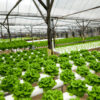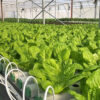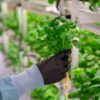Hydroponic farming is based on technology, which is the most productive and advanced soilless farming method for growing vegetables in a controlled environment. Vegetables and fruits grown here are disease-free, fresh, tasty, and nutritious. This soilless agriculture is practiced without the use of fertilizers, pesticides or chemicals, paving the way for some of the most complex and profitable ventures. Hydroponics is a new soilless agriculture in which plants are grown in soilless nutrient solutions.
Hydroponics Benefits
- Produces Higher Yields
- Require Less Labor
- Needs No Soil
- Produce Higher Quality Food
- Reduce Supply Chain
- Predictability and Seasonality
- Crops Grow Faster
- Maximize Space
- Conserves Water
- Facilitates Micro – Climate
Future of Hydro Farming
Urban hydroponics is modern, research-based soilless agriculture. It retains all the nutrients in the water and avoids the use of pesticides and fertilizers to eventually grow disease-free plants. This very specific aquaculture farm represents a big future growth for start-ups and would-be entrepreneurs. According to the latest report from DataM intelligence, the hydroponics market in India is expected to reach a CAGR of 13.53%. Hydroponics, which is currently in its infancy, is expected to reach this level between 2020 and 2027, so maximum productivity could be reached a few years after India installs its hydroponics system.
During Covid 19 – Against the backdrop of the pandemic in India, India is facing major challenges in terms of productivity and transportation of vegetables and fruits to vulnerable areas. So by introducing hydroponics into communal homes and installing a hydroponics system, the same food becomes available to all households across the country.
We Croptek Agri Grower , Hydroponic Farming in Vadodara always put quality at first. Our farms are equipped with the latest technology to grow crops in a safe environment that not only looks good, but produces high yields! All systems are designed and tailored to your specific requirements. Before developing an effective system, the team considered what they were planting as well as other factors such as light quality or water availability.




